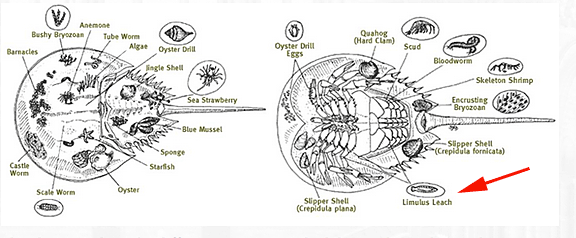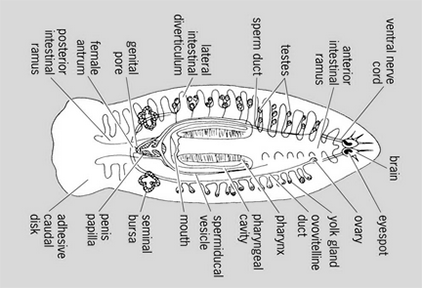Most of you have some experience with this group if only from introductory biology lab. It an interesting group that contain free-living and parasitic forms. In fact it is one of the two crown clades containing the most species of human and their domestic animal common parasites. We will explore the parasitic species as part of the take home portion of the second exam, but in the meanwhile, examine the free-living forms whose "bauplan" at one time was considered that of the potential last common ancestor. They now have been rejected as such, because of lack of a coelom.
Brown planaria
Review important characteristics such as how planaria move and feed. You may want to increase the size of the third film to see the cilia more clearly.
Feeding
Locomotion in brown planaria, note muscular as well as ciliary driven movement.
Cilia close up
In lab, we have used a more transparent form because it is easier to view internal anatomy. This is a species, Bdelloura candida, which is found on the legs and within the book gills of horseshoe crabs. It is still debated as to whether it is a commensal, or an ectoparasite that is capable of wounding or at least feeding on the wounds of the horseshoe crab. It appears that gills of old horseshoe crabs or those who appear in poor condition can become compromised if packed with the eggs of these worms.
View the films taken by students of this species for comparison of structure and behavior to that of the brown planaria, Dugesia sp.
General anatomy: Internal reproductive structures and digestive tract of horseshoe crab leech can more easily be observed than with brown planaria.
Feeding in Bdelloura candida, worm is using its head to push food into pharynx which is visible at end of film.
Locomotion in B. candida, note ciliary movement of one worm and muscular movements in adjusting position of other worm.
Acoels
Many taxonomists debate whether acoels should be part of the Platyhelminthes or considered a separate line of worms. They are small colorful worms, but can overpopulate a tank in a few weeks as they feed on anything they can, alive or dead. Below are films of a colorful form, where eyespots are apparent and a more transparent species, in which the simplicity of their internal anatomy can easily be viewed.
Nemertea
We have never been successful in getting these to feed under the lights of the camera, although they live for long periods in our tanks. This is an extraordinary group of "worms', that can prey on animals many times their size. Their proboscis can come equipped with toxic tips. The film below and You tube link will allow you to compare these animals to flatworms.
Nemerteans as flatworms use cilia and muscles in locomotion.
tThese websites give more information on feeding in this group. The last site features a species closely related to the one we have examined in our laboratory.
https://www.earthtouchnews.com/wtf/wtf/so-what-is-that-worm-with-the-unbelievable-mouth/
https://www.youtube.com/watch?v=7RFmk_ZVMm8&feature=emb_rel_pause
https://www.youtube.com/watch?v=55wChToy5fM

